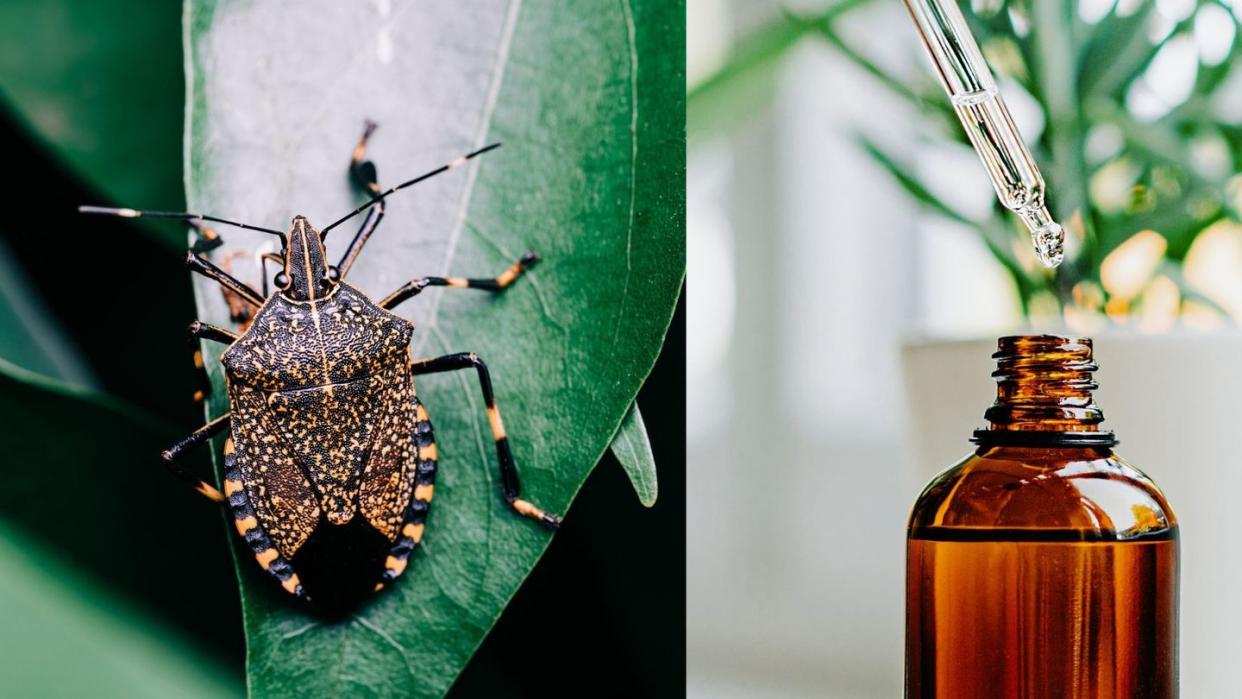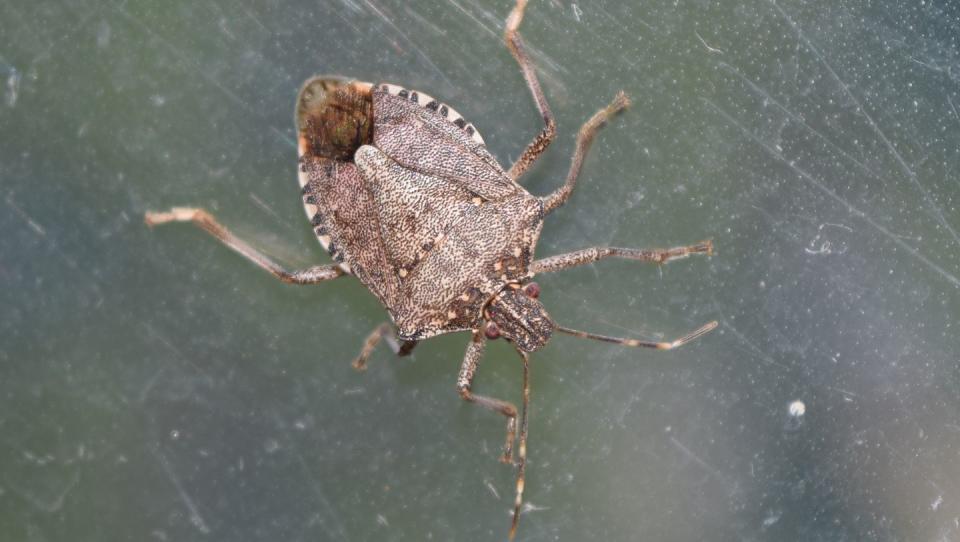This Is the Best Way to Get Rid of Stink Bugs for Good

"Hearst Magazines and Yahoo may earn commission or revenue on some items through these links."
[table-of-contents] stripped
Stink bugs are disgusting, plain and simple. The nasty, diamond-shaped critters can crawl in through open windows, pipes, and even unsealed wall cracks. When they arrive, they seem to do so by the dozen—that's why you might have so many in your house at once. No matter how they get in, figuring out how to get rid of stink bugs is the real challenge. Luckily, these little pests aren't harmful to you, your pets, or your home, but they are called stink bugs for a reason: They release a gross sulfurous smell if you crush them.
Crushing critters is a tried-and-true method of disposal for a number of bugs found around the home, but with stink bugs, squashing them is the one thing you want to avoid. So we're not going to waste any time. We asked entomologist Chad Gore, PhD, market technical director for the pest-control company Terminix, to explain not only how to get rid of stink bugs immediately but also prevent them from coming back next season.
"It's sometimes difficult to prevent a stink bug infestation," Gore says. "Because of this, it's important to hire a professional to help you determine your risk, identify opportunities for sealing the building and excluding stink bugs, and treating the building with insecticides at the right time of year to reduce the likelihood they'll bother you in the winter and early spring."
Ahead, you'll find expert solutions for how to get rid of stink bugs as well as tips to keep them away, including minor home repairs and natural repellents. These strategies will actually help prevent all sorts of unwanted pests from invading your home, including fruit flies, house flies, and all types of cockroaches.
What Are Stink Bugs?
There are many types of stink bugs in the United States, but the kind that usually comes inside your house is brown marmorated stink bug. They're an invasive species that originated in East Asia and was accidentally introduced in Pennsylvania in the late 1990s, according to PennState Extension. Since then, the shield-shaped, winged bugs have spread across the country. They can't do structural damage to your home, but they can damage your plants and potentially trigger your allergies.
What Attracts Stink Bugs
Warmth, food, light, and moisture—like pretty much any pest, stink bugs are simply look for what they need to survive. You'll likely notice stink bugs in your house when the weather starts to cool in the fall and early winter. They'll look for any opening to get in.
How to Get Rid of Stink Bugs

Remove and Release
You may feel compelled to, but don't step on or crush stink bugs the way you might other creepy-crawlies. Remember, getting smashed is what releases their revolting stench. You can trap a stink bug in a cup (just put it on top and slide a piece of paper underneath) and release it outside or sweep or vacuum them up. If you use a vacuum cleaner, just make sure to replace the vacuum bag and throw the used one out or empty the dust bin right away.
How to Prevent Stink Bugs
"One of the biggest mistakes made when dealing with stink bugs is waiting until they're already inside to try and do anything about them. By the time they're inside, it's too late," Gore explains.
Seal Entry Points
It's probably difficult to figure out where exactly the little buggers are coming in, but that's exactly why you should seal off any and all potential entry points. It could be a screen window or door, a crack in the countertop, or really any hole or niche. Stink bugs can squeeze into very small spaces. According to Orkin, they most often sneak in through "cracks, crevices, gaps and holes in foundations, window and door frames, soffits, attics, and underneath siding." So adequate sealing with clear silicon is a must. Pay extra attention to entry areas near fruit trees, gardens, or other agricultural hot spots since they tend to attract stink bugs.
Protect With Insecticide
Sometimes the only way to truly prevent insects is with a chemical deterrent. Gore recommends consulting a professional to determine the most at-risk areas of your home—usually windows, exterior doors, crawl spaces, and attics—and line those spaces with an insecticide at the end of the summer to try and avoid the bugs coming inside to escape the dropping temperatures. "Spraying insecticides might kill some as they emerge from attics, around fixtures, or from wall voids (assuming you've been lucky enough to guess accurately where they crawl out of and they walk across the material)," Gore says. If you really want to get rid of stink bugs, though, you need to treat the exterior of your home in the fall. "The best approach is to target them in the fall on the outside of a building. This means applying residual insecticides to the exterior of a building, to the cracks and crevices they may try to enter (gaps around windows and doors, under fascia, gaps in soffit, attic vents, chimneys, around utility penetrations, etc.)."
Tidy Up the Kitchen
If you've just been using chip clips, you might want to reassess and switch to airtight food storage containers. Food attracts stink bugs just like other pests. The goal is to make it harder for stink bugs to survive and thrive once they're in your home, so eliminating their access to food will make it less appealing to them. Trust us, you don't want to find a stink bug in your brown rice or tortilla chips.

Keep Moisture Levels Down
Super-humid places with water buildup or poor ventilation are breeding grounds for stink bugs. Moisture attracts stink bugs too. So dry it up, whether that means investing in a great dehumidifier or fixing a leaky faucet. You can also temporarily tape over any emergency drainage points if you think the bugs are coming in through the drain.
Get an Essential Oil Diffuser
Certain essential oil scents can help repel stink bugs, but they don't kill them. No scent kills stink bugs. For a 2013 research study published in Journal of Applied Entomology, researchers tested several essential oils as stink bug repellents, and found that "all the tested individual essential oils and a ternary oil blend showed significant repellency to both BMSB nymphs and adults." The study determined that the most effective and best essential oils to get rid of stink bugs are pure clove oil, lemongrass oil, spearmint oil, and ylang-ylang oil. Less effective but still helpful options include wintergreen oil, geranium oil, pennyroyal oil, and rosemary oil, which showed a 60 to 85 percent reduction in stink bug attraction to a bait trap.
Turn Off the Lights at Night
Like most insects, stink bugs are drawn to lights. If you keep your porch light (or any light for that matter, once they get their way inside) on after dark, they'll flock to it. The simple answer? Turn off the lights or put them on a motion-detection timer so they turn on only when someone walks by—that's more energy efficient and cost effective anyway.
FAQs
Why Do Stink Bugs Come Indoors?
Like any creature, stink bugs can't survive the winter cold, so they search for a warmer place to wait the season out. "The arrival of cool weather triggers them to search for someplace to spend the winter," Gore explains. "In the spring, stink bugs that passed through the winter successfully and are able to leave their overwintering habitat will be attracted to plants of many varieties (host plants) in order to lay their eggs. This gives the newly emerged (hatched) insects a head start by starting life out on a plant they can feed from."
Can You Have a Stink Bug Infestation?
Infestation might be the wrong word. Stink bugs aren't like ants or bed bugs that can cause damage; they're mostly just a nuisance. "If you do find that you have a lot of stink bugs outside, then it's important to hire a professional to help you determine how best to treat and where on your home/building needs to be sealed up," Gore says. "The best prevention is to exclude them and make it difficult for them to get inside. If you've missed the opportunity to seal them out and find yourself with a lot of stink bugs inside, then it's best to vacuum them up and discard the vacuum contents."
Follow House Beautiful on Instagram and TikTok.
You Might Also Like

